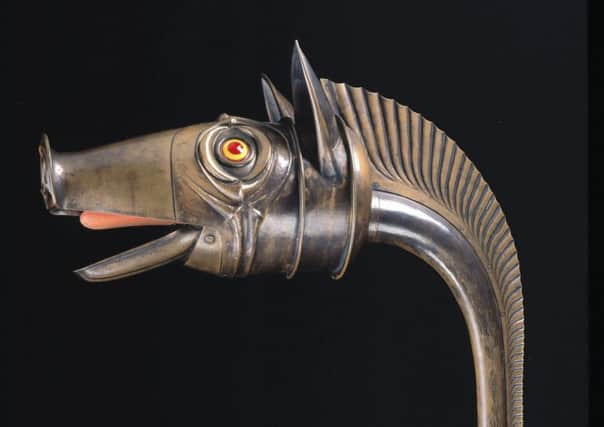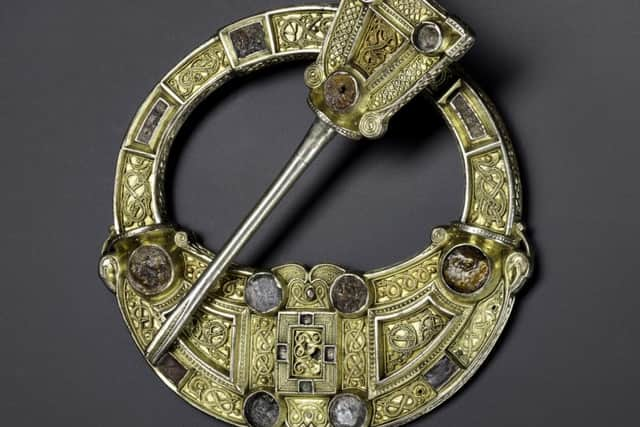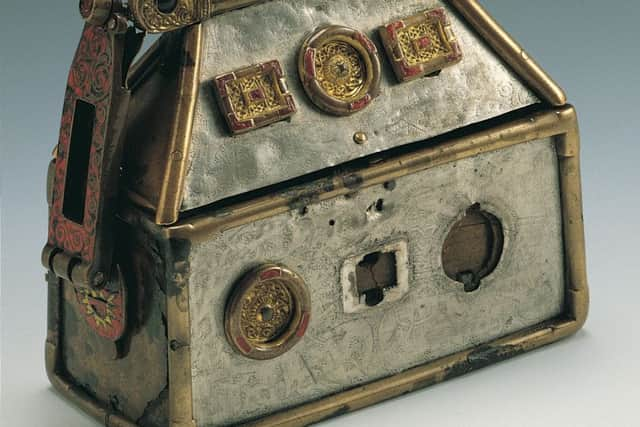What Celtic treasures reveal about their existence in Iron Age and medieval Europe


The Caledonian Mercury on December 17, 1812, carried news of a remarkable find in a bog in Dumfriesshire. The Torrs “pony cap” – think a horned helm for a horse – made in elaborate metalwork engraved with Celtic patterns, has now been dated to the second century BC.
No ordinary horse wore this object. The animal and its rider were part of an elite – what archaeologists smilingly call an Iron Age jet-set - who engaged the best craftsmen, and whose horizons stretched far beyond their own locale. The pony cap is to take pride of place in a major new exhibition of Celtic art at the National Museum of Scotland which challenges us to take a much wider view of Celtic Europe. “The style on it links it to Ireland, Eastern England, France and Bulgaria,” says Fraser Hunter, principal curator of the Iron Age and Roman Age collection at NMS. “Whoever is dressing up their pony in that is showing these connections. This object takes us from a bog near Castle Douglas to this much wider story.”
Advertisement
Hide AdAdvertisement
Hide AdThe exhibition, created in partnership with the British Museum, and featuring several important loans from museums overseas, makes an striking contribution to the ongoing debate about the Celts: who were they, where did they come from? While recent books have focused on languages, and on the analysis of both ancient and modern DNA, the exhibition tells its story purely through objects. Artefacts such as the Torrs pony cap are recognisably “celtic”, but so are chariot fittings from Mezek in Bulgaria or jewellery from a grave in Baden-Wurttemberg, Germany, in the period before the Roman occupation. What, then, is Celtic?


“In the Iron Age, from 450BC-200BC, when we see first stuff that is called Celtic emerging, the story stretches from Ireland to the Black Sea,” says Hunter. “It takes us into these big European pictures, moments of contact, connection, change, seen through these artefacts. It emphasises that we’re not just a wee island on the edge of nowhere, we’re tied into these much bigger pictures.”
The traditional idea of the Celts as a single, powerful nation which once occupied much of Northern Europe and was gradually pushed back to the fringes of Scotland, Ireland, Wales, Cornwall and Brittany, is now largely discredited. Martin Goldberg, senior curator in archaeology, Iron Age, Roman and early history at NMS, points out that this was largely an invention of the 18th century, and is now annexed for every purpose from football to Scottish nationalism and selling kitsch to tourists. Some experts question whether the term “Celtic” has any validity at all. “Nobody talks about there being Celts in Britain until the 17th century. The concept of a Celtic ‘race’ emerges in the Victorian period, it’s a type of terminology we don’t really use in archaeology. It doesn’t mean there is this unbroken lineage stretching back to the Iron Age and covering the whole of Europe.”
“It’s not a single people or a single culture,” adds Hunter. “What we’re dealing with is an infinitely more complex and therefore far more interesting story. It’s not as simple as the story of one group called The Celts or one thing called Celtic art, there are lots of different people who get called Celts, or call themselves Celts, and there are lots of different kinds of Celtic art. Over 2,500 years, it’s constantly reinvented, revived, reconsidered. People in different places and times are drawing on their own traditions, drawing on what they’re exposed to, creating new forms of links to the past.”
The story the exhibition tells is more diverse and surprising than the stereotypical view would suggest. There are remarkable similarities in the styles of art found across Europe in the Iron Age, the abstract patterns, plaits and knots, the strange animal forms, the intriguing disregard for artistic realism. In Britain, these styles persisted longer than in the rest of Europe, partly as a resistance to the Roman occupation, then transformed again to express the arrival of Christianity. The best of the objects offer an insight into a culture far stranger, more diverse and more sophisticated than we had imagined.


In the case of the Gundestrup cauldron, a stunning silver bowl from the first century BC which is on a rare loan to the UK from the National Museum of Denmark, the term “Celtic” is stretched to its limits. The beaten and moulded plates on its sides show recognisably Celtic animal forms and carnyx-blowers alongside Indian elephants and figures who might have come from the Near East. “It’s the perfect example as to why only talking about Celts is too limited,” says Hunter. “It was made most likely in Bulgaria, it shows influences from Western Europe, the Near East, India, and it ends up in a Danish bog. If that doesn’t show an internationally connected world, I’m not sure what does. It lifts our horizons beyond simple ideas about Celts and shows what a complicated, intertwined world we’re dealing with.”
Even the seventh century Hunterston brooch, one of the most prized and popular objects in the NMS’ own collection, is far from local. Goldberg says: “People have looked at it for a long time and thought ‘That’s a Celtic brooch’, but actually it tells you a much bigger story. It’s probably made in Ireland, it’s covered in goldwork, which would have been more common in the Anglo-Saxon world, it’s got amber settings which would have been traded from the Baltic, and the back has a 10th century inscription in Scandinavian runes. It shows how diverse early medieval Scotland was at that point.”
Advertisement
Hide AdAdvertisement
Hide AdAll this poses as many questions as it answers, and makes the job of trying to understand the Celtic world more complicated than ever. “The paradox is we know a hell of a lot more now than the Victorians did, and yet they were a lot more certain about things,” says Goldberg.
“Their story was simpler, and they only had a limited amount of material to work with, whereas almost every discovery opens up a new avenue of research for us. We have a richer tapestry, but a lot of it is still missing.” “But that’s what makes it fun,” says Hunter. “Simple stories are not convincing. The world is not simple, it doesn’t resolve into simplistic blocks and groups, that’s why the story’s an exciting one, and that’s what people are going to discover when they come and see this show: a far richer more interesting story than they ever imagined.”
• Celts: Art and Identity, National Museum of Scotland, sponsored by Baillie Gifford Investment Managers, 10 March 10-25 September, www.nms.ac.uk